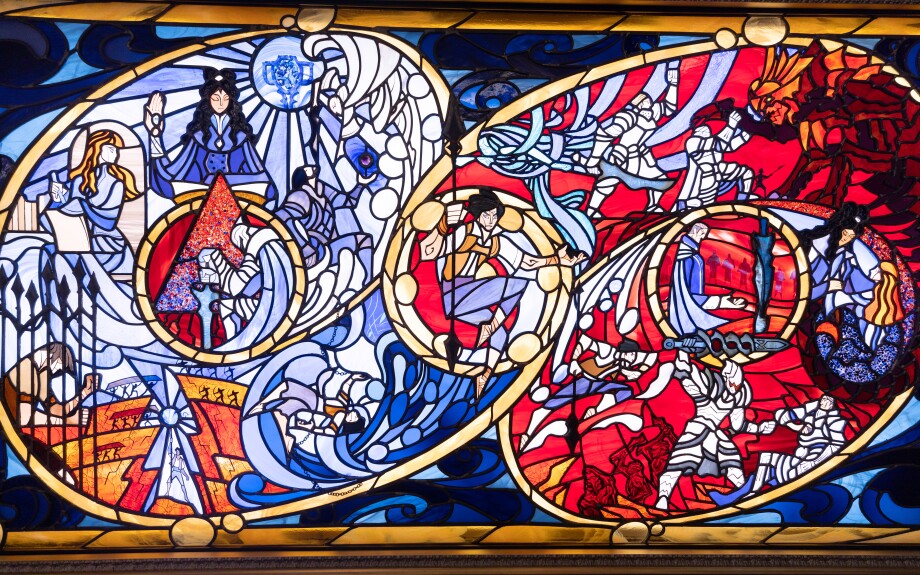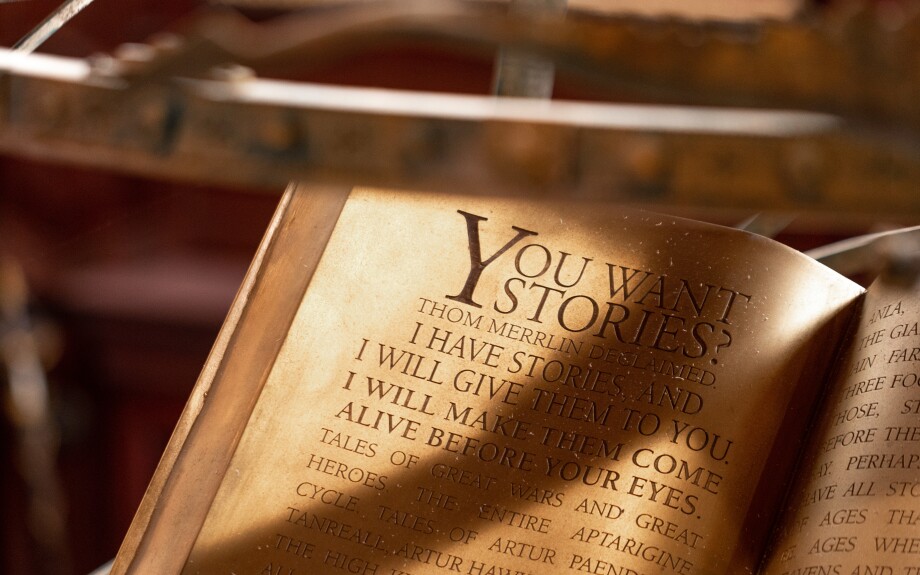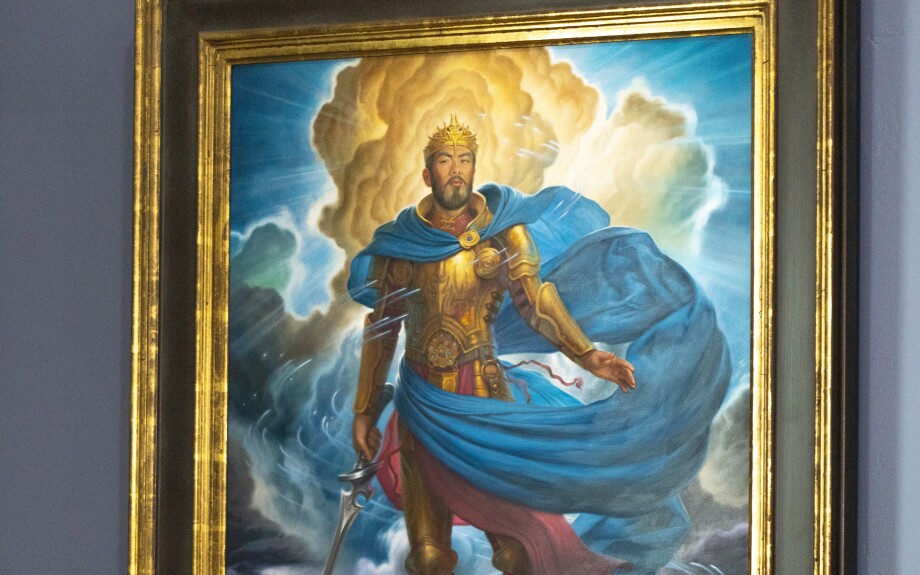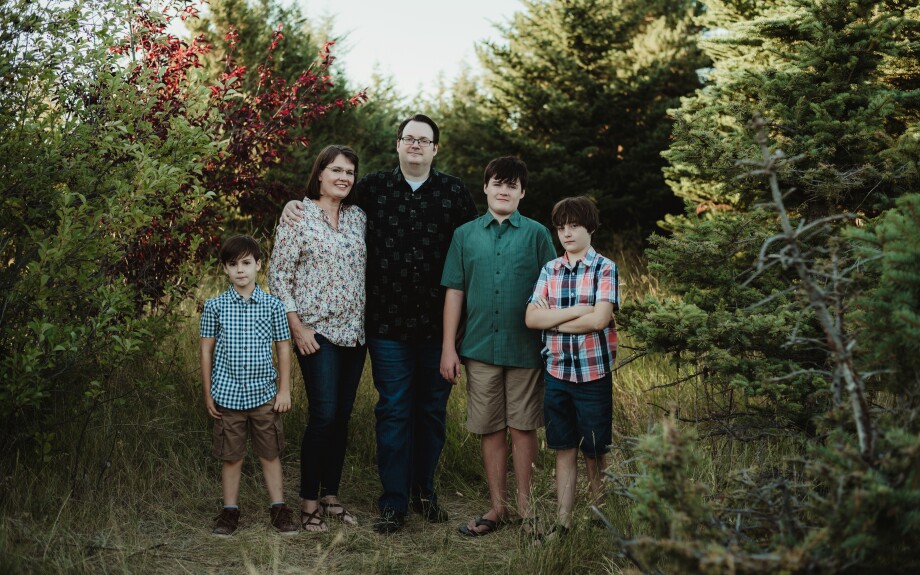
Brandon Sanderson looks up at the sky.
He contemplates the constellations above him: A warrior wielding a sword against a snakelike dragon. An intricate oil lamp lit by flame. The head of a woman deep in thought, her hair spilling into the expanse of the night.
Some lights among the stars shine brighter than the rest. Each one is a planet, the glowing orbs like beacons in the dark. There’s Roshar. Scadrial. Taldain. Nalthis. Brandon knows these mythical worlds well, as they’re an integral part of a fictional universe he’s created called the Cosmere.
A star chart of the Cosmere stretches across the ceiling of Brandon’s study, giving a glimpse of the complexity of the universe in which many of his books are set. That cosmos Brandon has created is so fantastic and engaging that his words effortlessly transport readers to a whole other dimension. Rich with magic systems, fantastical creatures, plot twists, intricate worlds, and well-crafted characters, the writer’s books are made of the stuff The Lord of the Rings lovers dream of. In fact, Brandon is already ranked right up there with the trilogy’s beloved writer: Audible has placed both him and J.R.R. Tolkien on its list of best fantasy authors ever.
But praise for Brandon’s works doesn’t end there. One of his most popular books, Mistborn: The Final Empire, was named by both Time and Forbes as one of the best fantasy novels of all time, and it was included in NPR’s top-100 list of readers’ favorite science fiction and fantasy books. Brandon’s novels have also been on the New York Times Best Seller list a staggering 15 times, with his book Oathbringer debuting in the No. 1 spot. That same novel was also the most preordered book in Audible’s 20-year history when it came out in 2017.
If that wasn’t enough, the movie industry has also taken an interest in Brandon’s works; DMG Entertainment optioned rights to his Cosmere novels in 2016, and in 2017 MGM optioned rights to his novella Snapshot. Many of his other books have also been optioned for movie or TV deals.
More impressive, though, is the storyteller himself. Because while Brandon is devoted to concocting stories in new worlds, he does much more than write—with a natural tendency to think big picture, he’s a teacher, podcast host, and founder of his company, Dragonsteel Entertainment. Additionally, during the COVID-19 pandemic, he secretly wrote four novels and started a Kickstarter fundraiser, allowing readers to purchase the books and receive copies throughout 2023. The goal was to reach $1 million from backers, but the campaign did that and then some—raising nearly $42 million, it more than doubled the previous record holder for the most successful Kickstarter campaign in history.
But even more important, Brandon approaches his personal life with that same big-picture perspective. So by prioritizing his faith, family, friends, students, and readers, he is more than a master of adventure and imagination; he is the protagonist of his own unparalleled story.
The Dreamer
It’s on an unassuming taupe couch in the middle of his study where Brandon appears most comfortable. In fact, while he isn’t the fastidious type, comfort was the one requirement he had when this piece of furniture was chosen—and since it’s where he writes for hours a day, every day, the specification seems only fair.
Brandon’s study seems to be a window into his mind. Dark wooden bookcases lining the walls display art from his stories, glittering rocks, a selection of Terry Pratchett novels, and a complete set of The Wheel of Time by the late fantasy writer Robert Jordan. The author’s wife, Harriet McDougal, asked Brandon to finish the series after her husband passed away in 2007, and it’s clear the edition on these shelves is one of a kind.

And yet, for all the intriguing atmosphere, there is also a surprising amount of normality to the space; beside the couch is a pair of worn black tennis shoes, and Brandon’s laptop, decorated with a Pokémon sticker from his kids, is kept handy nearby. Writer is written on every inch of this room, but a few decades ago, that label was Brandon’s best-kept secret.
“I hid my writing away, … embarrassed of it,” Brandon says of his teenage self. “There was a painting in my room, and I would hide the manuscript, after I printed it out, behind the painting so that nobody would find it, because I was sure [people] would make fun of me.”
His love for fantasy had been ignited a couple of years before, in eighth grade, when Brandon was swept off his feet by Barbara Hambly’s Dragonsbane, which a teacher had given to him. Just a couple of years later, he felt a need to write that he couldn’t ignore.
“I found something, if you’ll pardon the pun, magical in these books, and I wanted to learn how to do it. I had to,” he says. “When I read these books that were really touching me and showing me things and taking me to new worlds, … I decided I’ve got to learn, [I’ve] got to figure it out. And so I started writing. I was terrible.”
His first manuscript was written on an electric typewriter and was only about 15 pages—a far cry from his later novels, like Oathbringer, which totals 1,248 pages in print. But while he may have begun as a closet writer, his mom, Barbara Sanderson, recalls that her son couldn’t keep his new passion entirely hidden away in high school. She remembers the first time she knew Brandon was developing an exceptional talent and that his teacher was also amazed at the substantial progress he’d made in writing.
“I remember reading one [story] that just blew me away. It was a story that he’d made up about a king, and it was unbelievable,” Barbara recalls. “I remember after that going to his [parent-teacher conference], and [his teacher] said, ‘I can’t believe this. … He could be teaching me.”
I found something, if you'll pardon the pun, magical in these books, and I wanted to learn how to do it. I had to.
With the spark of writing ignited, when Brandon left for a full-time mission in Seoul, Korea, he wanted to continue the craft he loved and recalls asking his mission president if he could write on preparation day. When he was given permission, Brandon wrote in a giant sketchbook during his free time while his companions played ping-pong.
His perseverance paid off. Eight months after returning home from his mission, Brandon finished the book he’d spent two years slowly plugging away at. Although he never felt the story was quite good enough—it was the first novel he’d ever completed—years later, he rewrote the entire thing from scratch. While a published book didn’t come from that rewrite, he ended up using some of the ideas in a graphic novel.
Brandon’s experience in Korea has shaped the content of his books. “Living as a minority in a country, learning to immerse yourself in another culture, just helps us understand how people think, how cultures develop—and it’s really essential if you’re going to create your own,” he says. “My very first published novel, Elantris, used … Korean linguistics as a foundation for part of the language, and … the magic in that world is language-based.”

After his mission, Brandon changed his major at Brigham Young University from biochemistry to English, intent on becoming an author. The decision worried his mom, who had previously advised Brandon that writing could be a hobby, but that he needed a more reliable way to support himself.
“When he came back from his mission and changed [his major], I was about ready to have a heart attack,” she says. “I knew he was a great writer, but you know, that’s so hard to break into, and so many great writers don’t make it.”
But Brandon was determined, and while working as a night clerk behind the front desk of a Provo hotel, he had plenty of time to write. Thirteen manuscripts later, he still hadn’t sold a book. But, despite a growing pile of rejection letters, in 2003 he submitted Elantris, which editor Moshe Feder at Tor Books accepted. Now, after publishing 32 novels (not counting graphic novels, middle-grade books, short fiction, novella collections, and his four secret novels), Brandon reflects on how he believes writing has been a part of his mission in life.
“I had a strong spiritual prompting that pursuing writing was a thing that would be good for me,” he says. “Whether that means I was destined to be a professional novelist? Well, it turns out I did end up becoming one, so maybe. … It might be providence, it might be luck, that what I enjoy writing tends to be things that people enjoy reading.”
The Family Man
While Brandon is well established in the writing world now, he had only published one book, Elantris, when he met his wife, Emily Bushman. The two had been set up on a blind date by Isaac Stewart, a mutual friend who started drawing maps for Brandon’s books in 2005.
“[Isaac’s] pitch for Emily was, ‘She’s read The Wheel of Time, Brandon. She likes fantasy books!’” Brandon recalls. A favorite joke of Emily’s, Brandon adds, is that at BYU “you should be handed the blind date punch card, and if you’ve managed to survive 10 of them, you get a free marriage.” That proverbial punch card must have been filled up for the two of them, the author says, because he and Emily hit it off from their very first date in 2005. In 2006, they were married in the Mount Timpanogos Utah Temple. Their first year of marriage they survived off the $5,000 Brandon made from his writing as well as Emily’s middle-school teacher’s salary of $27,000.
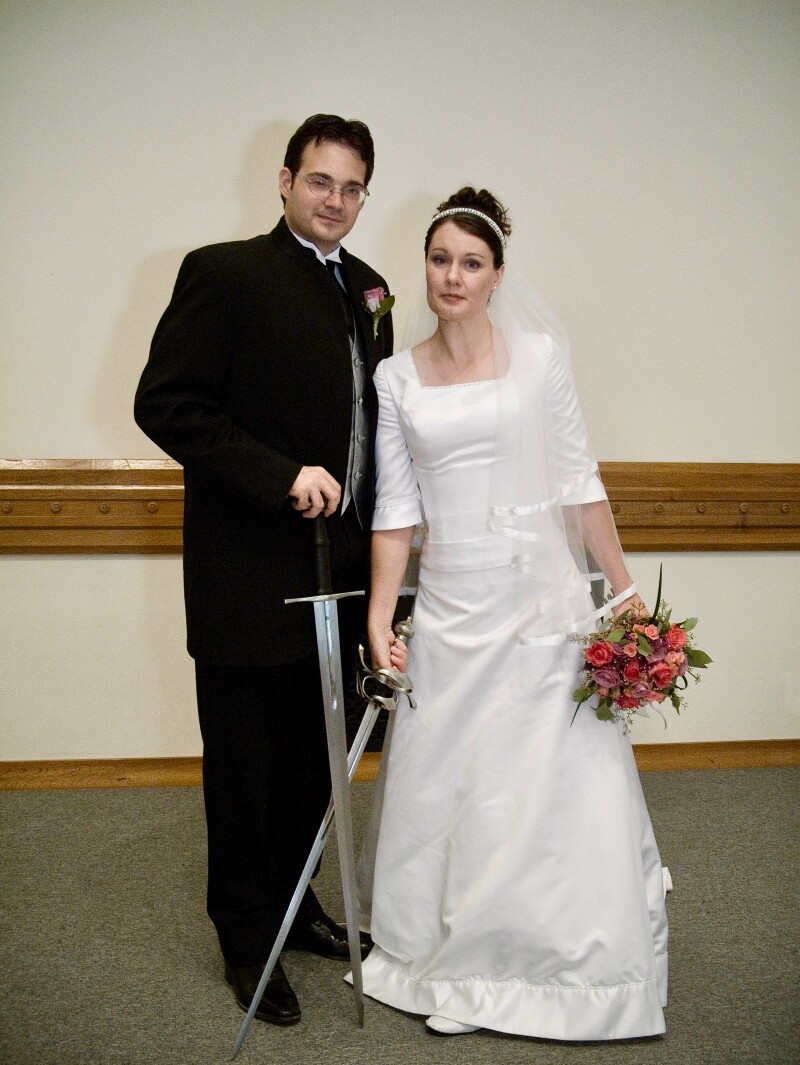
Now, Emily works part time as chief operations officer for Dragonsteel Entertainment, the Sandersons’ company that self-publishes some of Brandon’s books and operates a merchandise store. Her job is to handle the logistics of the company to make sure everything functions, giving Brandon time to write. “I learned early on in our marriage a certain look that he gets [when he’s] in the zone, and I try really hard not to interrupt him,” Emily says.
While the couple works from home, their days look a little different from most. A true night owl, Brandon typically wakes up at 1:00 p.m. and starts his day by reading his scriptures and working out. Then from 2:00 p.m. to about 6:00 p.m., he writes. The next four hours is family time, during which Brandon deliberately avoids writing—or even thinking about it.
“My brain is not in writing mode during that time. So when I’m with my family, I’m with them, rather than counting the moments until I can get back to the stories—because writing can be an all-consuming thing. A lot of writers will find that they spend all their waking time thinking about the books,” he says.
After family time, Brandon works from 10:00 p.m. to 2:00 a.m., followed by two hours where he can unwind before going to bed. He isn’t the only night owl in the family, though—it’s not uncommon for Emily or one of their three sons to stay up well into the night reading.
Their boys have also taken a liking to writing themselves and each has already written at least one story of their own, usually with Brandon’s help. The family enjoys building with Legos, too, and often do so on Sundays to have projects to work on together that don’t involve a screen. And they have a small collection of pets: Brandon has a macaw nicknamed Jell-O, and his boys take care of a tortoise and a leopard gecko. Brandon and Emily hope that the boys’ responsibilities, as well as their parents’ example of hard work, will help teach them strong principles.
“I think most of the ways you teach children to work is to work with them,” says Emily. “And they can’t sit and help Brandon write or things like that. But I do think it’s important for them to see him work, and see us work, and be involved.”
At church, Brandon serves as a gospel doctrine teacher, and Emily works in the Primary presidency. The callings are good fits for both of them; Emily finds her administrative job experience useful in Primary, and Brandon is an experienced teacher, having taught popular creative writing and workshop classes at BYU for the past two decades.
“I enjoy asking questions and provoking answers and getting a discussion going,” he says. “I’ve been doing it for quite a while in my ward. I hope that … the Lord continues to let me for many years to come. My [mom’s ward] had a single gospel doctrine teacher for 20 years. I’m hoping maybe I can have something like that.”
The Researcher
When it comes to his writing, Brandon prefers presenting themes over allegories. So instead of using obvious metaphors with a “one-to-one correlation” the way C.S. Lewis did to teach a moral lesson, Brandon says he opts for a more open-ended exploration of ideas and questions, like Tolkien did in his works.
“As a writer, I think that one of my callings is to try to make the world a better place. I think that I am in the position I am to do good. The good is, I don’t think, to write very moralistic allegorical pieces. It is instead to show, the best I can, real people struggling with difficult choices. … And show that we can have a lot of different viewpoints and still get along in the end,” he says.

Coby Davis, a fan who has read nearly all of Brandon’s novels and even proposed to his wife by placing a ring in Brandon’s The Way of Kings, says the writer’s ability to accurately depict people’s challenges is one of the things that he admires most.
“What I love is the characters, and specifically the character Kaladin from The Way of Kings because he’s just so similar to me, mainly in the way that Brandon Sanderson writes about Kaladin’s depression,” Coby says, explaining that in his life he has struggled with those feelings at times.
He also appreciates the amount of research Brandon puts into his books to get things right. “I’m a chemist, and his magic that he writes is very scientific. And especially in his most recent book, Rhythm of War, there’s a whole arc about scientists trying to figure out how the magic works,” he says. “And that’s what it’s like to be a scientist. It was very accurate. And it was very exciting as a scientist to see it portrayed very accurately.”
The Explorer
Early on as a writer, Brandon had a breakthrough in his storytelling that has forever influenced his work. He found that when he thought of characters as archetypes that filled a specific role, they felt flat. But when he looked at them as the protagonists of their own stories, with complex desires, they became more lifelike.
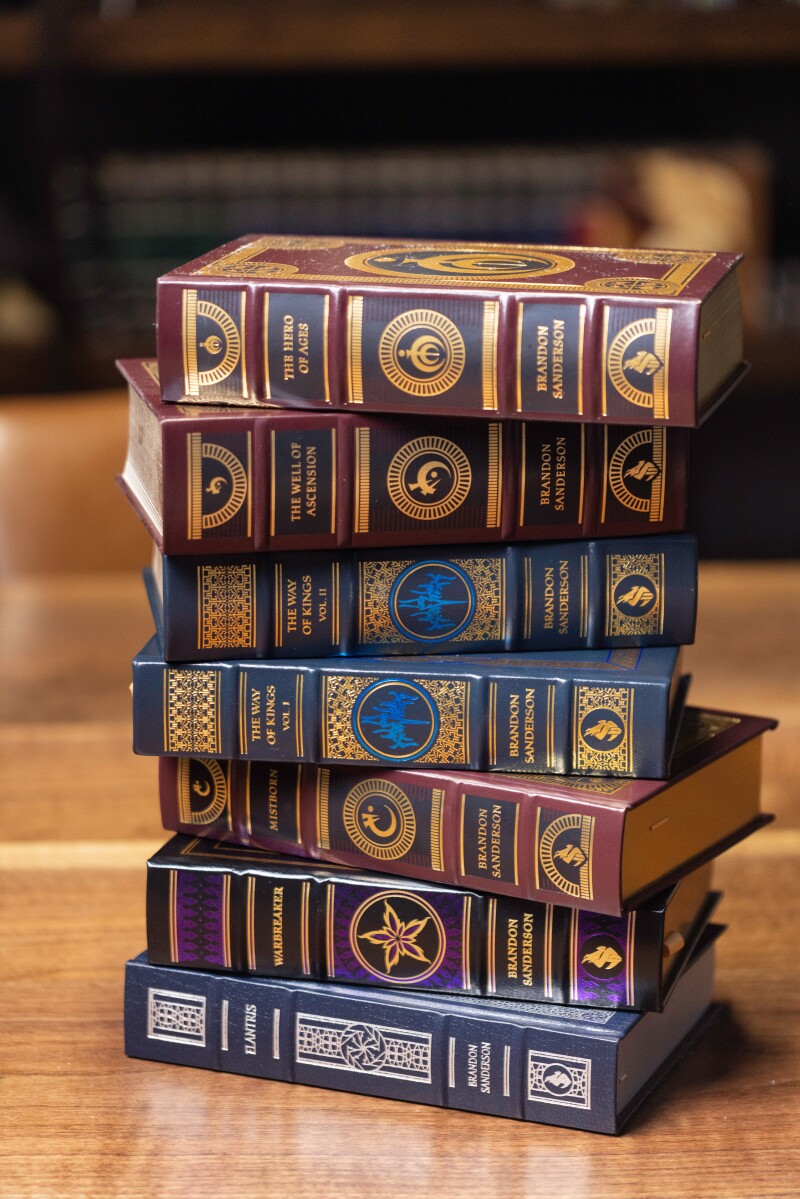
It’s the same, he says, with real people—nobody is an archetype that fits a particular mold, even though we often see those around us as one-dimensional characters.
“When looking at other people, we want to say, ‘OK, this is the person that does this. They are in that box.’ And that’s not how God sees us. God sees that we have a whole bunch of sometimes conflicting motivations,” he says.
Those conflicting motivations have been a part of the world from the very beginning, he continues. In fact, he likes to think of them as the basis of scripture.
“The very first story we have in the scriptures involving human beings, or mortals, is [Adam and Eve] being given two contradictory commandments. I think that having to deal with contradictions is the soul of what we’re supposed to learn in this life. And when we look at somebody else and be like, ‘They’re a hypocrite’—well, Christ can say that, because He knows their hearts. But we don’t.”
I think that having to deal with contradictions is the soul of what we’re supposed to learn in this life.
There are even contradictions within antagonists, Brandon explains. Though they’re committing dark deeds, they believe in their hearts that they are doing them for the right reasons.
“On a smaller scale, the people who are villainous in our lives—the person who cuts us off in traffic, the person who swears at us, or types mean things about us on the internet—even with them, I like to try [and] say, ‘All right, what’s their perspective? Why are they doing this? Who are they?’ And that makes for more interesting stories,” he says.
The Storyteller
For all the thought he puts into stories, Brandon devotes his time and energy to the people around him, including his family, friends, students, fans, and employees. His mom, Barbara, explains that he gives back to the community through the Lightweaver Foundation, a nonprofit Brandon and Emily established. The foundation promotes literacy and helps provide food, water, shelter, and clothing to those in need both locally and worldwide.
Isaac Stewart, who still creates maps for Brandon and is now vice president of creative development at Dragonsteel Entertainment, says his friend loves to share what he has with others and “cares a ton about people and how they are experiencing the world.” He’s also seen firsthand the effect that Brandon’s books have on people’s lives.
“I have been at book signings with Brandon where I’ve seen the toughest of people with tears in their eyes because Brandon’s books have touched them in some way and made their lives better,” he says.
Stories, Brandon says, have value for many reasons. For one, they help readers learn empathy. For another, they help people live vicariously through characters so they can better deal with circumstances in their own lives.
“I’ve often wondered why we dream. Why, when we go to sleep, do we tell ourselves stories—sometimes very frightening stories? And I think one of the purposes is the same reason that we read—going through and practicing through vicarious storytelling helps us have capacity in life. I really think that it does. And maybe that’s too high and mighty for somebody who tells stories about dragons and wizards. But I think that this is the good of story,” he says.
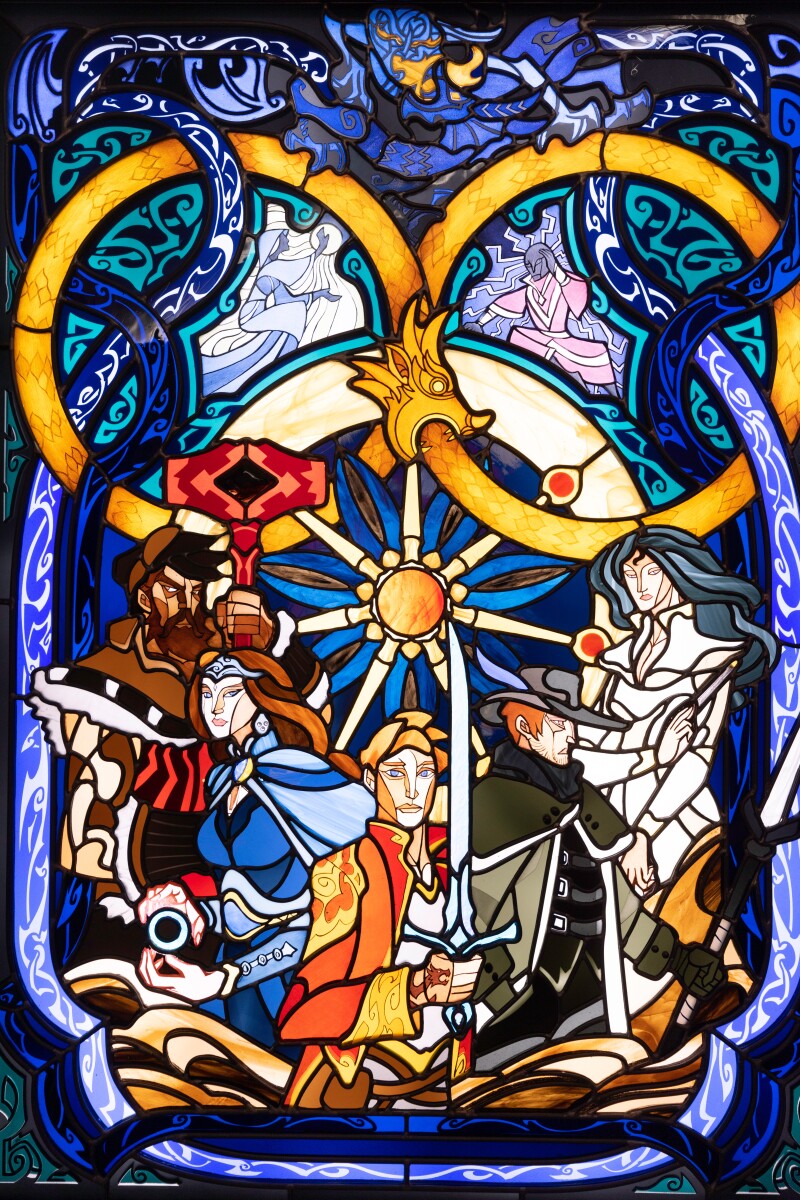
And so, the storyteller spins his tales. Deep in a study, day after day, he works his magic. Writing satiates a burning need within him, but his creations, in the end, are for them—the readers.
“There is currently nothing temporal that I would want that I can’t have. So why do I keep working? It’s for them. … I have been put in a position where I have a moral obligation and a duty to take what I’ve been given and do something with it.”
But he also writes for the memory of his younger self—a determined young man who once journeyed into the unknown. Looking there and back again, Brandon knows that the road he embarked on is one he wants to keep traveling.
“I write because I need to. But if you go back to the core of why I need to, it’s because of the way that books helped me,” he says. “So many thousands of people want to be writers professionally. I spent … 10 years in a no-man’s-land of, Will I ever sell a book? Will I have a career? What are my backups if I don’t? I wrote 13 novels before I sold one. I look back at that person, and I say, I need to keep writing because that person wanted it so badly. And I still love it.”
▶You may also like: Inside the Numbers: Brandon Sanderson


